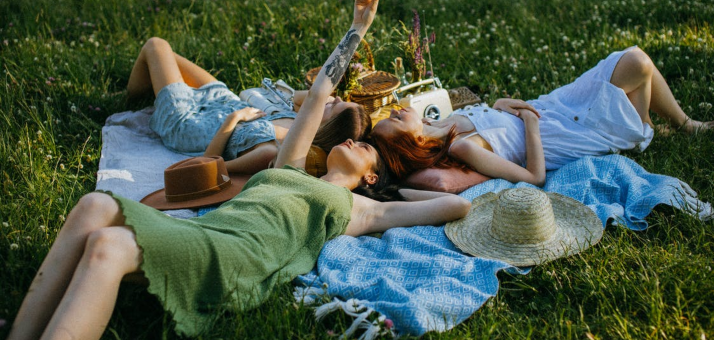
8 Types of Grass Seed - How to Choose the Right One
Many of us dream of having a beautiful lawn and lush green grass to surround our homes.
But owning a beautiful lawn takes time and effort. You have to learn practical skills to plant and grow grass seeds properly. Furthermore, you need to know what grass seed types are appropriate for your lawn based on your region, climate, and level of maintenance you can manage.
The first thing you need to know about lawn grasses is that they are of two types: cool-season grasses and warm-season grasses.
To understand the concept better, let's go over eight different types of grass seed—four cool-season and four warm-season ones.
Warm-season grass seed

Warm-season grass seed thrives in areas with hot summers. They also thrive in direct sunlight and have a higher summer heat tolerance. Warm-season grasses primarily prefer temperatures between 75 and 90°F to grow. They become inactive and brown during the chilly late-fall and winter months and don't green up until warmer seasons arrive in the spring. The following are among the warm-season grass varieties:
1.Bahia grass seed
Bahia grass is a warm-season grass and has been popularized as lawn grass as it can thrive in nutrient-poor soils with little to no maintenance, something many other types of grass cannot. It grows fast and does not require fertilization.
Bahia grass lacks the typical well-kept lawn appearance and has a rough texture. When not properly managed, it develops a seed head.
Bahia grass seeds are slow to germinate at first, but once ingrained, they grow quickly. Therefore, instead of purchasing sod, planters can grow Bahia grass from seed. It is an excellent choice for homeowners who live in warm areas with sandy soil and poor growing conditions.
2. Bermuda Grass Seed

Bermuda grass is a warm-season grass used for both residential and recreational lawns, such as golf courses and football fields. This grass is resistant to both heat and drought; it can survive with just 1 inch of water per week. It is also resistant to repeated use, making it an excellent choice for lawns with heavy foot traffic, children, and pets.
The roots can go as deep as 6 feet, even though they often stay within six inches of the surface. Compared to other warm-season lawn grasses, this one has a deeper root structure and is more resilient to environmental challenges.
3. Zoysia Grass Seed

Another popular warm-season lawn grass is Zoysia grass. It is an excellent choice for gardeners looking for low-maintenance, warm-season grass that is also resistant to cold temperatures. It doesn't need to be watered or fertilized on a regular basis. It tolerates shade better than other warm-season grasses.
Since Zoysia grass grows slowly, some gardeners prefer to start with sod. However, it can also be grown directly from seed. It tolerates low mowing heights, making it popular for lawns and golf courses.
4. St. Augustine Grass Seed
St. Augustine grass, another warm-season grass, is also known as buffalo grass. It is the least cold-tolerant of the common warm-season grasses and thrives in hardiness zones 8 through 10. It is difficult for this grass to grow from seeds. Therefore, laying down sod is the best option when you want to grow this type of grass.
St. Augustine grass can have a noticeable bluish tint in appearance. It has broad leaves with semi-rounded tips that grow thickly. It is very tolerant of salt and humidity, making it ideal for lawns in coastal areas, particularly those near the Gulf Coast.
Cool-season grass seed:

Cool-season grasses thrive in areas with cold weather, preferring cooler daytime temperatures. Their shade tolerance is slightly better than warm-season grasses. These adaptable grass species have no trouble with bitterly cold winters or temperate summers. No matter how cold it gets, these specially bred grasses maintain a lush, green lawn.
The ideal temperature range for cool-season grass growth is between 65 and 80°F. All gardeners who reside in areas having cool temperatures can use cool-season grasses. The following are the most common varieties of cool-season grass seeds.
1. Perennial Ryegrass Seed
Perennial ryegrass is the quickest-germinating lawn grass seed. It grows in the cold season and can grow from scattered seeds to a lawn in as little as 21 days. Because of its short lifespan, perennial ryegrass is most commonly used as a temporary filler to patch up damaged lawns.
It is frequently seeded over dormant warm-season grasses in the winter to provide greenery. It usually dies out by the time the warm-season grasses become active again.
The grass grows thicker in some areas and not so thick in others, making lawns look blotchy. Hence, this grass type is not always the best option in terms of aesthetics. It is, however, a pest-resistant and low-maintenance grass.
2. Fine Fescues Seed
Fine fescue is another cool-season grass commonly used in lawns. Fine fescues are typically composed of a blend of multiple fescue seeds. This grass is distinguished by its distinct foliage and soft texture, which can give your lawn a lush green aesthetic.
Fine fescue has gained popularity in recent years due to its environmental sustainability. It is a slow-growing lawn grass with low moisture and fertilization requirements. The most amazing thing about this grass is that it remains green all year. Fine fescue is a low-maintenance grass that can thrive in areas with limited sunlight; too much sunlight can sometimes negatively impact its growth.
3. Kentucky bluegrass seed
Kentucky bluegrass is perennial, cool-season lawn grass. It means that it reappears each year and blooms most rapidly in the coldest months of spring and fall.
It is most commonly used in locations with cold winters and relatively warm summers, which are more conducive to its natural preferences and development cycle.
Kentucky bluegrass makes a dense, lush, long-lasting lawn when given the right growing conditions and lawn care. Despite its slow growth and relatively high maintenance requirements, its rich color and texture make it the ideal lawn grass.
Early fall is the best time to plant Kentucky bluegrass seeds. That is when they thrive and germinate.
4. Tall fescue seed
Tall fescue is a cool-season lawn grass in the fescue genus of plants. The grass has a deep roots system, making it more heat and drought tolerant than other cool-season grasses.
Tall fescue grows best when grown from seed. The best time to plant these seeds is in the spring, when temperatures range from 60 to 75 degrees. Watering once a week can be beneficial to its growth. And frequent watering is not required unless there is extremely hot weather.
Tall fescue is known for its adaptability and disease resistance. It’s an excellent choice for anyone looking for a thick, long-lasting lawn that can withstand a wide range of environmental factors.
How to choose the right grass seed?
There are no two grass seeds that are similar in characteristics. From agricultural grass species used to feed livestock to cool-season grasses used for urban lawns, each variety has unique characteristics and requirements that determine whether it will grow or not. It all mainly depends on where the grass is planted.
Given below are a few things to consider when choosing the best grass seed to plant for a well-maintained lawn.
Climate
Climate can speed up or slow down the process of seed germination. It is, therefore, one of the most crucial factors influencing grass growth, hence, the selection of grass seed for your lawn.
Severe cold or heat in a region can cause root damage to grass due to the rise and fall in soil temperature. You should invest time in researching what grass seeds can endure the climate in your region so that you can get the lawn you have always desired.
Sunlight vs. Shade

Observe how much sunlight falls on the lawn to determine whether it is sunny or shady. It will significantly impact the types of grass seed you plant. Sun-loving grass will not grow on a heavily shaded lawn and will die, whereas shade-tolerant grass will flourish.
Green Carpet's "Traffic":

Determine how much foot traffic your lawn will receive. Dainty grasses cannot survive when subjected to excessive wear and tear, especially if intensive restoring therapies are not given. On the other hand, self-mending grasses, such as Kentucky bluegrass, will not become "shaved" even if children play on the lawn often or your dog is particularly fond of digging holes.
Maintenance Requirements
Some grass types are achingly high maintenance. They need you to protect them from long and full sun exposure or plenty of sunshine; in some cases, water them often, replace patches, fertilize, mow, and so on.
But, there are also a lot of species, like fescues, that do not require such high maintenance. These species are naturally resistant to bugs and fungi and are not prone to many diseases. They also have low water requirements and can flourish in various conditions. As a result, it ultimately comes down to just how much money and time you are willing to spend on your green spaces.
Testing your soil

When making changes to your growing space, it's always a good idea to test your soil first. Soil tests are inexpensive and simple to perform and can provide you with a clear picture of overall soil health as well as specific characteristics of the soil, such as sandy, acidic, low-nitrogen, and so on.
Once you know what's really going on with your soil, you can select grass seed that will thrive in your yard. Testing your soil also allows you to make corrective changes to improve the health of your soil, providing a stronger and healthier foundation for your lawn.
Conclusion
Choosing an appropriate grass seed is challenging, but we hope this information helps you select the best grass seed for your lawn and garden. Happy planting!
Products
View all

